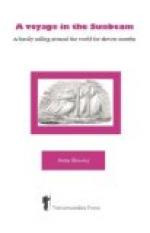We went to see three Fuegian females, who are living in a house belonging to the medical officer of the colony. They were picked up a short time since by a passing steamer from a canoe, in which they had evidently sought refuge from some kind of cruelty or oppression. The biggest of them, a stout fine-looking woman, had a terrible gash in her leg, quite recently inflicted, and the youngest was not more than eight years old. They appeared cheerful and happy, but we were told that they are not likely to live long. After the free life and the exposure to which they have been accustomed, civilisation—in the shape of clothing and hot houses—almost always kills them. Their lungs become diseased, and they die miserably. Their skin is slightly copper-coloured, their complexions high-coloured, their hair thick and black; and, though certainly not handsome, they are by no means so repulsive as I had expected from the descriptions of Cook, Dampier, Darwin, and other more recent travellers.
[Illustration: Fuegian Weapons.]
Saturday, October 7th.—My birthday. Tom gave me a beautiful guanaco-skin robe, and the children presented me with two ostrich rugs. The guanaco is a kind of large deer, and it is said that the robes made from its skin are the warmest in the world. People here assure me that, with the hair turned inside, these robes have afforded them sufficient protection to enable them to sleep in comfort in the open air, exposed to snow, frost, and rain. They are made from the skin of the young fawns, killed before they are thirteen days old, or, better still, from the skins of those which have never had an independent existence. In colour, the animals are a yellowish brown on the back, and white underneath, and they are so small that when each skin is split up it produces only two triangular patches, about the size of one’s hand. A number of these are then, with infinite trouble, sewed neatly together by the Indian women, who use the fine leg-sinews of the ostrich as thread. Those worn by the caciques, or chiefs, have generally a pattern in the centre, a brown edging, and spots of red and blue paint on the part which is worn outwards. Such robes are particularly difficult to obtain, on account of the labour and time necessary to produce them. Each cacique keeps several wives constantly employed in making them, of the best as well as of the ordinary description. The ostrich rugs, which are made here, are more ornamental, though not so warm and light as the guanaco robes. They are made of the entire skin of the ostrich, from which the long wing-feathers have been pulled out. Mabelle has been given a beautiful little rug composed of the skins of thirty little ostriches, all from one nest, killed when they were a fortnight old, each skin resembling a prettily marked ball of fluff.




